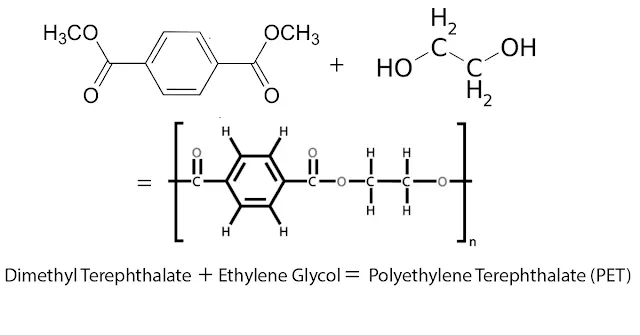Introduction
{getToc} $title={Table of Contents}
- Polyester fiber/filament is a manufactured fiber in which the fiber-forming substance is any long-chain synthetic polymer composed of at least 85% by weight of an ester of a saturated aromatic carboxylic acid.
- Polymers of monomeric units are joined by ester linkage.
- Developed by ICI (UK) Terylene in 1948, and DU Pont (USA) Dacron (1951).
- Polyesters are commonly made by the interaction of dibasic acid with dihydric alcohol.
 |
| PET Production Process New |
Another Process (old)
 |
| PET Production Process Old |
- Condensation reaction (280-290℃). Esterification is carried out.
- Antimony trioxide (Sb2O3) is used to start and control the reaction.
- TiO2 is added to make polyester fiber/filament dull.
- When the desired degree of polymerization is reached, the colorless polyester is extruded.
Dyeing Process
Dispersion of dispersed dye into the water
↓
Adsorption of the dye onto the fiber surface
(at HTHP method 130-140℃, at carrier method at 80℃)
↓
Diffusion of dye molecules from the surface to the interior of the fiber
Production Flow Chart
Preparation of raw materials
↓
Mixing tank
↓
Polymerization in the reactor
(Temperature 260-290℃, 3-6 hrs) (Ester interchange, polycondensation reaction)
↓
↓
Melt SPG
↓
Polyester filaments (Mono/multiplication)
↓
↓
Reeling onto a package or texturization)
Polymer Characteristics
DP = 115-140
Length = 120-150 nm
Thickness = 0.6 nm
Chemical Groups:
-CH2- = Methylene
-CO = Carboxyl
-OCO- = Ester
End Uses of Polyester
- Apparel and house furnishings
- From shirts to pants to jackets and hats
- Bedsheets
- Blanket upholstered
- Furniture
- Car tires
- Safety belts
- Coated fabrics
Characteristics of Polyester
- It is strong, very durable, quick-drying, wrinkle resistant, mildew resistant, retains its shape, and is hydrophobic in nature.
- It does not absorb water, but it can be produced in such a way that (as in polypropylene and microfibers) wicks water away from the skin.
Physical and Chemical Properties
Tags
Synthetic Fibers